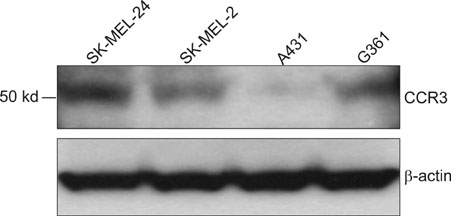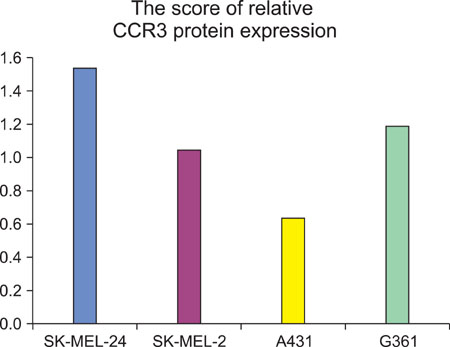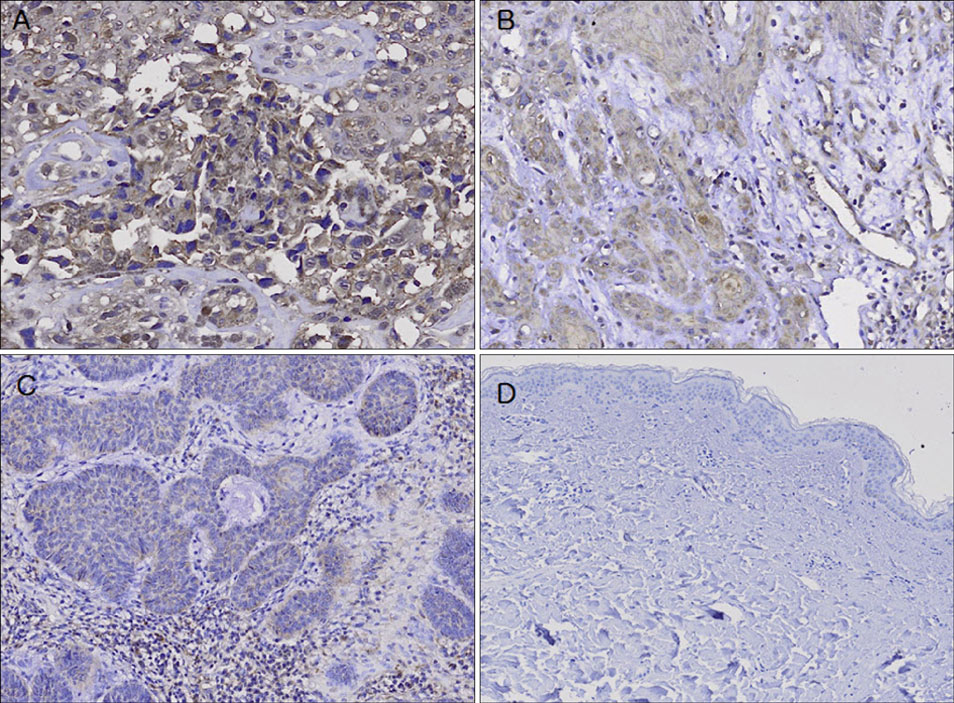Ann Dermatol.
2010 Nov;22(4):412-417. 10.5021/ad.2010.22.4.412.
Chemokine Receptor CCR3 Expression in Malignant Cutaneous Tumors
- Affiliations
-
- 1Molecular Cancer Research Center, College of Medicine, Soonchunhyang University, Cheonan, Korea.
- 2Department of Dermatology, College of Medicine, Soonchunhyang University, Seoul, Korea. mkcho2001@hanmail.net
- 3Department of Dermatology and the Cutaneous Biology Research Institute, College of Medicine, Yonsei University, Seoul, Korea.
- KMID: 2266177
- DOI: http://doi.org/10.5021/ad.2010.22.4.412
Abstract
- BACKGROUND
Chemokines and their receptors are important players in tumorigenesis by facilitating tumor proliferation and metastasis. Little is known about the possible function of chemokine receptors in relation to the development and progression of malignant cutaneous tumors.
OBJECTIVE
The aim of this study was to determine the chemokine receptor CCR3 expression pattern and the protein expression level in selected malignant cutaneous tumors.
METHODS
Four types of cell lines (G361, A431, SK-MEL-2, SK-MEL-24) were analyzed, using Western blotting, for the expression of CCR3 protein. Immunohistochemical staining for CCR3 was done on 36 skin cancer tissue samples that included 16 squamous cell carcinomas (SCCs), 16 basal cell carcinomas (BCCs), 16 malignant melanomas (MMs) and 6 normal tissue samples.
RESULTS
Western blot analysis showed that CCR3 protein was more expressed in the MM cell lines (G361, SK-MEL-2,SK-MEL-24) than that in the SCC cell line (A431), and the immunohistochemical analysis showed that CCR3 protein was overexpressed in MM and SCC, it was mildly expressed in BCC and it was hardly expressed in normal tissue.
CONCLUSION
This study demonstrated via immunochemistry that CCR3 was more expressed in MM, followed by SCC and BCC. The existence of CCR3 protein may enhance the tumorigenic potential of malignant cutaneous tumors.
Keyword
MeSH Terms
Figure
Reference
-
1. Shin JH, Cho SY, Whang KK, Hahm JH. An epidemiologic analysis of cutaneous malignant tumors over 15 years (1984~1998). Korean J Dermatol. 1999. 37:1743–1751.2. Seo PG, Moon SE, Cho KH. A statistical study of cutaneous malignant tumors (1996~2000). Korean J Dermatol. 2002. 40:129–137.3. Yoon TJ, Kim HS, Oh CW, Kim TH. A clinical investigation of cutaneous malignant tumors in western Gyeongnam province. Korean J Dermatol. 1997. 35:956–962.4. Jeong KB, Kim HC, Shin DH, Choi JS, Kim KH. A clinical observation of cutaneous premalignant and malignant tumors. Korean J Dermatol. 2002. 40:924–931.5. Mantovani A, Allavena P, Sica A, Balkwill F. Cancer-related inflammation. Nature. 2008. 454:436–444.
Article6. Coussens LM, Werb Z. Inflammation and cancer. Nature. 2002. 420:860–867.
Article7. Mantovani A. Cancer: inflaming metastasis. Nature. 2009. 457:36–37.8. Balkwill F. Cancer and the chemokine network. Nat Rev Cancer. 2004. 4:540–550.
Article9. Strieter RM, Polverini PJ, Kunkel SL, Arenberg DA, Burdick MD, Kasper J, et al. The functional role of the ELR motif in CXC chemokine-mediated angiogenesis. J Biol Chem. 1995. 270:27348–27357.
Article10. Dieu MC, Vanbervliet B, Vicari A, Bridon JM, Oldham E, Ait-Yahia S, et al. Selective recruitment of immature and mature dendritic cells by distinct chemokines expressed in different anatomic sites. J Exp Med. 1998. 188:373–386.
Article11. Zlotnik A, Yoshie O. Chemokines: a new classification system and their role in immunity. Immunity. 2000. 12:121–127.12. Kleinhans M, Tun-Kyi A, Gilliet M, Kadin ME, Dummer R, Burg G, et al. Functional expression of the eotaxin receptor CCR3 in CD30+ cutaneous T-cell lymphoma. Blood. 2003. 101:1487–1493.
Article13. Jöhrer K, Zelle-Rieser C, Perathoner A, Moser P, Ramoner R, et al. Up-regulation of functional chemokine receptor CCR3 in human renal cell carcinoma. Clin Cancer Res. 2005. 11:2459–2465.
Article14. Wang JM, Deng X, Gong W, Su S. Chemokines and their role in tumor growth and metastasis. J Immunol Methods. 1998. 220:1–17.
Article15. Schweickart VL, Epp A, Raport CJ, Gray PW. CCR11 is a functional receptor for the monocyte chemoattractant protein family of chemokines. J Biol Chem. 2000. 275:9550–9556.
Article16. Müller A, Homey B, Soto H, Ge N, Catron D, Buchanan ME, et al. Involvement of chemokine receptors in breast cancer metastasis. Nature. 2001. 410:50–56.
Article17. Takeuchi H, Fujimoto A, Tanaka M, Yamano T, Hsueh E, Hoon DS. CCL21 chemokine regulates chemokine receptor CCR7 bearing malignant melanoma cells. Clin Cancer Res. 2004. 10:2351–2358.
Article18. Letsch A, Keilholz U, Schadendorf D, Assfalg G, Asemissen AM, Thiel E, et al. Functional CCR9 expression is associated with small intestinal metastasis. J Invest Dermatol. 2004. 122:685–690.
Article19. Simonetti O, Goteri G, Lucarini G, Filosa A, Pieramici T, Rubini C, et al. Potential role of CCL27 and CCR10 expression in melanoma progression and immune escape. Eur J Cancer. 2006. 42:1181–1187.
Article20. Murakami T, Cardones AR, Finkelstein SE, Restifo NP, Klaunberg BA, Nestle FO, et al. Immune evasion by murine melanoma mediated through CC chemokine receptor-10. J Exp Med. 2003. 198:1337–1347.
Article21. Wang J, Seethala RR, Zhang Q, Gooding W, van Waes C, Hasegawa H, et al. Autocrine and paracrine chemokine receptor 7 activation in head and neck cancer: implications for therapy. J Natl Cancer Inst. 2008. 100:502–512.
Article22. Loukinova E, Dong G, Enamorado-Ayalya I, Thomas GR, Chen Z, Schreiber H, et al. Growth regulated oncogene-alpha expression by murine squamous cell carcinoma promotes tumor growth, metastasis, leukocyte infiltration and angiogenesis by a host CXC receptor-2 dependent mechanism. Oncogene. 2000. 19:3477–3486.
Article23. Miyagaki T, Sugaya M, Fujita H, Ohmatsu H, Kakinuma T, Kadono T, et al. Eotaxins and CCR3 interaction regulates the Th2 environment of cutaneous T-cell lymphoma. J Invest Dermatol. 2010. 130:2304–2311.
Article24. Zlotnik A, Morales J, Hedrick JA. Recent advances in chemokines and chemokine receptors. Crit Rev Immunol. 1999. 19:1–47.
Article25. Skinnider BF, Mak TW. The role of cytokines in classical Hodgkin lymphoma. Blood. 2002. 99:4283–4297.
Article
- Full Text Links
- Actions
-
Cited
- CITED
-
- Close
- Share
- Similar articles
-
- Relationship between the Level of CC Chemokine Receptor mRNA Expression and the Number of Infiltrated Eosinophils in Nasal Polyps and Inferior Turbinate Mucosa
- Chemokine Receptor Expression of Hepatitis B Virus-Specific CD8+ Lymphocyte in Chronic B Viral Infection
- CCR3 Monoclonal Antibody Inhibits Eosinophilic Inflammation and Mucosal Injury in a Mouse Model of Eosinophilic Gastroenteritis
- Roles of RUNX1 and PU.1 in CCR3 Transcription
- Analysis of Intraocular Chemokine and Chemokine Receptor in Patients with HLA-B27-associated Anterior Uveitis




